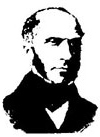Henry Darcy

Henry Philibert Gaspard Darcy lived from 1803 to 1858 and was a well respected and renowned scientist of his time. His name is still known among hydrologists. He is best known for his contribution to groundwater flow: the Darcy "Law" that groundwater flow is directly proportional to the head difference. However, he made substantial contributions to a much broader field of hydrological and hydraulic engineering. As an engineer responsible for the water supply of Dijon he carried out experiments to determine the characteristics of water flow through pipes of different material, size and roughness; and did filtration tests through sand filters of different sizes and filter material. He also carried out field experiments in open channels to determine the relations between velocity, cross-sectional area and slope. As a result of these experiments his name also appears in the Darcy-Weisbach equation for open channel flow.
His approach was purely scientific and in line with the empirical approach to science of that time. Besides his hydraulic experiments, he developed a theory for recharge of groundwater from rainwater infiltration, offered a rational explanation for the seasonal variation of the productivity of wells, and provided a theoretical explanation for the occurrence of artesian wells. Phenomena which in his time were still issues of serious debate.
What makes Darcy a particularly good figurehead for the "Hydrology and Water Resources" medal is that his research work was triggered by societal needs and the complex engineering challenges that came with an urbanising and industrialising society. An excellent narrative on the achievements of Darcy and the imprint he left on the city of Dijon is presented in Philips (1995).
Hubert Savenije
Philips, J.R., 1995. Desperately seeking Darcy in Dijon. Soil.Sci. Soc. Am. J., 59, 319-324.
